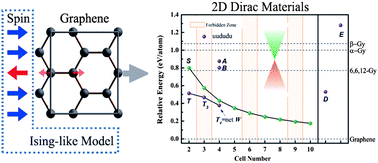Two dimensional Dirac carbon allotropes from graphene†
Abstract
Using a structural search method in combination with first-principles calculations, we found lots of low energy 2D carbon allotropes and examined all possible Dirac points around their Fermi levels. Three amazing 2D Dirac carbon allotropes have been discovered, named as S-graphene, D-graphene and E-graphene. By analyzing the topology correlations among S-, T, net W graphene and graphene, we found that a general rule is valuable for constructing 2D carbon allotropes that are keen to possess Dirac cones in their electronic structures. Based on this rule, we have successfully designed many new 2D carbon allotropes possessing Dirac cones. Their energy order can be well described by an Ising-like model, and some allotropes are energetically more stable than those recently reported. The related electronic structures of these Dirac allotropes are anisotropy distinguished from those of graphene. Moreover, the fact that D- and E-graphene present Dirac cones suggests that sp hybridization or sp3 hybridization could not suppress the emerging of Dirac features. Our results demonstrate that the Dirac cone and carrier linear dispersion is a very common feature in 2D carbon allotropes and can exist beyond the limitations of fundamental structure features of graphene.


 Please wait while we load your content...
Please wait while we load your content...